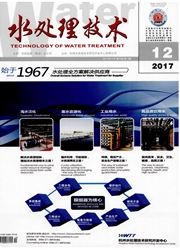

 中文摘要:
中文摘要:
以二苯甲酮(BP)为紫外接枝引发剂,将辣素衍生物N-(2,3,4.三甲氧基苯甲基)丙烯酰胺(TMBA)和丙烯酸(AA)接枝在聚砜基膜表面上以提高膜的抗菌性和耐污染性。在先前研究的基础上,试验固定接枝时间为15min,TMBA和AA的质量分数分别为1%和2%,溶剂为乙醇,通过表面接触角测定仪、全反射红外光谱、扫描电镜、水通量和截留率、耐污染性、抗菌性测试等方法来表征膜改性前后的结构和性能变化,研究引发剂BP含量对膜表面结构性能的影响。结果表明,改性后聚砜超滤膜的截留率、耐污染性等都得到很好的改善,尤其是改性膜的抗茵性得到了明显提高;当BP的质量分数为0.2%时,抑菌率达到95%左右,通量恢复率由基膜的25%提高到80%,可以证明改性后的聚砜膜具有了良好的抗菌性和耐污染性。
 英文摘要:
英文摘要:
The N-(2,3,4-top oxygen base benzyl)aerylamide (TMBA) and acrylic acid(AA) were ~fred onto polysulfone (PSF) ultrafiltration (UF) membrane using benzophenone (BP) as the initiator to improve the antibacterial and antifouling property. For modifications of PSf UF membranes, only UV light with λ〉 300 nm, or better λ〉 350 nm, can be recommended, because the polymer chain scission was suppressed by H-abstraction from methyl groups under long-wavelength UV irradiation (λ〉300 nm), which avoided the photodegradation ofPSF ultrafiltration membrane. Based on the previous experience, the effects of BP concentration to the modified PSF UF membrane were investigated by keeping the UV irradiation time as 15 min, TMBA and AA concentration as 1% and 2% respectively. The changes on the structure and properties were studied by measuring flux and rejection, contact angle (CA), Fourier transform infrared spectroscopy (FTIR-ATR), Scanning Electron microscope (SEM), and antibacterial analysis. The success grafting TMBA and AA onto the surface ofPSF UF membranes was verified by the presence of infrared absorption band at 1 645 cm^-1 and 1 720 cm^-1 The egg albumin rejection rate of the PSF UF membrane was increased from 89% to 96%, while pure water flue was still fine, with the increasing of BP concentration from 0 to 0.2%. At the same time, the recovery rate of pure water flux of the egg album fouled membranes increased from 25% to 80% after water flushing, which represented an enhancing of membrane antifouling property. The number and size of membrane pore decreased obviously, which explained the increase of rejection and the decrease of pure water flue. Escherichia coli was chosen to test the antibacterial activity of the membranes. Due to the antibacterial activity of TMBA, the modified membranes showed an enhancing antibacterial efficiency. The antibacterial efficiency was up to 95% when the BP concentration was 0.2%, while that of the unmodified membrane was only 21%. It was prove
 同期刊论文项目
同期刊论文项目
 同项目期刊论文
同项目期刊论文
 Preparation and Characterization of Hydrophilic PVDF Membrane via graft modification by Acrylic Acid
Preparation and Characterization of Hydrophilic PVDF Membrane via graft modification by Acrylic Acid Behavior and distribution of nonylphenol ethoxylates and their metabolites in sediments of Nansi Lak
Behavior and distribution of nonylphenol ethoxylates and their metabolites in sediments of Nansi Lak Preparation and Characterization of Hydrophilic PVDF Membrane via graft modification by Maleic Anhyd
Preparation and Characterization of Hydrophilic PVDF Membrane via graft modification by Maleic Anhyd Effect of annealing conditions on crystallization behavior and mechanical properties of NIPS poly(vi
Effect of annealing conditions on crystallization behavior and mechanical properties of NIPS poly(vi 期刊信息
期刊信息
